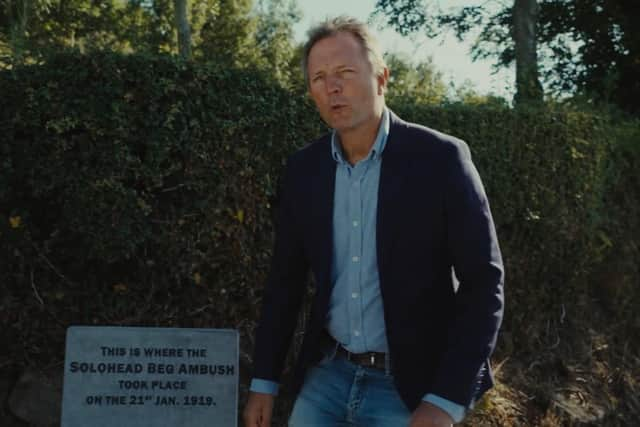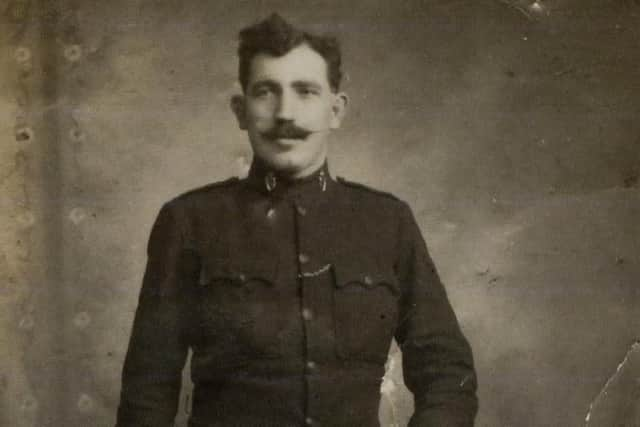Tony Connelly examines his grandfather Michael’s life in the RIC during the Tan War in new documentary
and live on Freeview channel 276
‘Tony Connelly: A Hidden History’, will be shown on RTÉ One at 9.35pm.
Part of RTÉ’s ‘Decade of Centenaries’ collection the film follows the RTÉ Europe Editor as he researches the life of Michael Connelly, a native of East Galway, who joined the RIC in 1908, long before the revolutionary ferment of the 1910s and 1920s.
Advertisement
Hide AdAdvertisement
Hide AdTony took two weeks out from reporting from Brussels, Berlin and Kyiv to make the film last summer.


He told the ‘Journal’ he was initially inspired to dig into his family history by the fractious debate around the Irish Government’s abortive 2020 proposals to commemorate 500 RIC men killed during the War of Independence.
“There was a huge backlash and the idea was dropped. It was unfortunate the debate blew up like it did. It got quite antagonistic. I think the nuances of history, the fact that it wasn't black and white, were lost in the clamour. I think that was one of the reasons I felt driven to write something or do some research,” he said.
Michael Connelly, Tony explains, was one of 13 children born into a poor Catholic farming family in Kilconnell near Ballinasloe.


Advertisement
Hide AdAdvertisement
Hide AdAt the time a posting with the RIC would have provided good prospects for man of his background and means.
“For a long time, before the revolutionary period, the RIC were just part and parcel of daily life. It was one of the few respected, pensionable, secure jobs a young Catholic farmer's son could get.
"It would have been quite common for someone from his background. At least one person in the family would maybe be a priest, someone else would be a policeman. It wasn't that controversial at that time when he was a recruit in 1908.”
Seven years after joining the force Michael wed Nora Flynn, the daughter of a schoolteacher from Castlegregory on the Dingle peninsula.


Advertisement
Hide AdAdvertisement
Hide AdWhile making the documentary Tony discovered how the local newspaper the ‘Kerry Advocate’ reported the occasion.
“It had a little article on the front page about the wedding. It talks about the two of them heading off to Dublin for their honeymoon and their friends and family wishing them years of connubial bliss. I thought that was quite poignant because that was in 1915 and he had no idea of what was coming down the track.”
Michael’s early policework in Kerry included such cases as ‘a man fined sixpence for allowing his two donkeys to wander on the public road’ but not long after he was married he was posted to Carrick-on-Suir in South Tipperary, a hotbed of militant republicanism.
Advertisement
Hide AdAdvertisement
Hide AdIt was at Soloheadbeg, for example, just over 30 miles from Carrick where two of Michael’s colleagues James McDonnell and Patrick O’Connell became the first victims of the War of Independence when when they were ambushed by the 3rd Tipperary Brigade.
“South Tipperary was a very hot location. You had Dan Breen and the South Tipperary 3rd Brigade. He would have known all those guys. In the documentary we uncover a friendship he had with an IRA engineer at the time and how that was all handled,” explains Tony.
By the start of the Tan War, Michael had three children to raise but was subject to an IRA boycott and an assassination attempt.
“The IRA imposed a boycott on all RIC men and their families. There was an attempt on his life in Carrick-on-Suir. Ultimately they had to flee the country and go to England and ended up in the North, first in Ballycastle, then Armoy and finally in Larne.
Advertisement
Hide AdAdvertisement
Hide Ad“He ended up in Larne as a Catholic RUC Sergeant, in a very loyalist town. There was graffiti next to the RUC station saying ‘Sergeant Connelly is an IRA man’. He couldn't win!”
Tony said taking time to focus on this very personal story had been rewarding.
“It became a bit of a detective story. I had the help of some historians who were working in this area and were extremely helpful and knew were to look. There are just enough of the archives out there to find little bits of evidence here and there which will tell you a lot.”
The Bureau of Military History archive of depositions taken from former members of the IRA in the late 1940s and 1950s was invaluable.
Advertisement
Hide AdAdvertisement
Hide Ad"They interviewed dozens of old IRA men who were probably beginning to die out. That was a back door into what was happening in South Tipperary and Carrick-on-Suir.
"I uncovered things about my grandfather from that angle which was a huge breakthrough. There were a couple of references to him and even though they were short they fed an awful lot that you could begin to flesh out. It was a really fascinating exercise in research.
"Then talking to my father [Tim] and my aunt Mary in Toronto who is 98 now...I did a long Skype call with her last year and she had loads of memories about him and about growing up. That added to the colour of it.”
Amid the controversy over the mooted RIC memorial Tony was struck by a tendency among some to conflate ordinary RIC officers with the ‘Black and Tans’ recruited as counter-revolutionary auxiliaries during the Tan War.
Advertisement
Hide AdAdvertisement
Hide Ad"Certainly my grandfather was not a Black and Tan. I don't know where he stood on the national question. He was from a very humble background and that must have been the case for thousands of RIC men.
"The thing about it is the Anglo-Irish Treaty differentiates RIC men who joined before 1919 from those who joined after in the way they should be treated. Michael Collins and Lloyd George both recognised the RIC men prior to the War of Independence were probably just ordinary decent policemen.”
